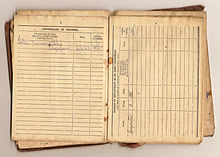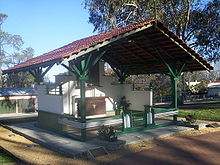- Changi Prison
-
Changi Prison (Chinese: 樟宜监狱; Malay: Penjara Changi; Tamil: சாங்கி சிறைச்சாலை) is a prison located in Changi in the eastern part of Singapore.
Contents
History
First prison and POW camp
Changi Prison was constructed by the British administration of the Straits Settlements as a civilian prison, in 1936.
During World War II, following the Fall of Singapore in February 1942, the Japanese military detained about 3,000 civilians in Changi Prison, which was built to house only 600 prisoners. The Japanese used the British Army's Selarang Barracks, near the prison, as a prisoner of war camp, holding some 50,000 Allied—predominantly British and Australian—soldiers.[1] Although POWs were rarely, if ever, held in the civilian prison, the name Changi became synonymous in the UK, Australia, and elsewhere with the POW camp.
About 850 POWs died during their internment in Changi during the Japanese Occupation of Singapore,[2] a relatively low rate compared to the overall death rate of 27% for POWs in Japanese camps.[3] However, many more prisoners died after being transferred from Changi to various labour camps outside Singapore, including the Burma Railway and the Sandakan airfield.
Allied POWs, mainly Australians, built a chapel at the prison in 1944 using simple tools and found materials. British airman Stanley Warren painted a series of murals at the chapel. Another British POW, Sgt. Harry Stodgen built a Christian cross out of a used artillery shell. After the war, the Chapel was dismantled and shipped to Australia, while the cross was sent to the UK. The chapel was reconstructed in 1988, and is now located at the Royal Military College Duntroon, Canberra.
Second prison
In 2000, the prison was demolished and its inmates were relocated to a new consolidated prison complex in a neighbouring site. In view of its historical significance, the Preservation of Monuments Board worked with the Singapore Prison Service and the Urban Redevelopment Authority to allow the front gates of the old prison to be preserved and moved to the new prison. In 1994 Changi Women’s Prison and Drug Rehabilitation Centre was opened.
Presently, the new Changi Prison houses the most serious criminal offenders in the country, including criminal offenders who are serving long sentences and those who have been sentenced to death. It serves as the detention site for death row inmates at Changi, before they are executed by hanging, traditionally on a Friday morning.
Changi Prison is also one of the main places (though not the only one) where judicial corporal punishment by caning is carried out. Caning sessions at Changi are held twice per week. A former employee of the prison has been quoted as saying: "They are flogging more and more these days. Before they were doing maybe 60 on Tuesdays and Fridays, now they're doing a hundred".[4]
Changi Chapel and Museum
In 1988, Singapore built a replica chapel (which was built by the POW's) and museum next to the Changi Prison. When Changi Prison was expanded in 2001, the chapel and museum was relocated to a new site 1 km away and the Changi chapel and museum was officially established on 15 February 2001.
Prominent detainees
Prisoners of war
- Sir Norman Alexander Professor of Physics, Raffles College, Singapore, Vice-Chancellor, Ahmadu Bello University, Nigeria. Helped build a salt evaporation plant at Changi and a small industrial plant that fermented surgical spirit and other products for prison hospital.
- Geoffrey Bingham, AM, MM, (6 January 1919 – 3 June 2009), who returned to Australia and wrote several books reflecting on his experiences, including his conversion to Christian faith in The story of the Rice Cakes,[5] Angel Wings,[6] and Tall Grow the Tallow Woods.[7]
- Russell Braddon, (25 January 1921 – 20 March 1995), Australian writer, who wrote "The Naked Island" about his POW experience.
- Sheila Bruhn (née Allan), who wrote about her experiences in Diary of a Girl in Changi.
- Anthony Chenevix-Trench (10 May 1919 – 21 June 1979), Headmaster of Eton College, 1964–1970.
- James Clavell is one of the most famous survivors; he wrote about his experiences in the book King Rat.
- Eugene Ernest Colman, chess master.
- Carl Alexander Gibson-Hill, medical doctor and Director of the Raffles Museum.
- John Hayter, Anglican priest who later wrote of his experiences in Priest in Prison.[8]
- Percy Herbert, actor.
- Sir Percy Alexander McElwaine, the Chief Justice of the Straits.
- Jim Milner AM (1933–1937)—Former Chairman Washington H. Soul Pattinson and former President NRMA. [9]
- Sir Alexander Oppenheim, mathematician. In 1984, he published "The prisoner's walk: an exercise in number theory", based in part of his experiences at Changi.
- Sir Harold Atcherley, businessman, public figure and arts administrator.
- Lieutenant-General Arthur Ernest Percival, commander of Allied forces in Singapore, following his surrender to the Japanese; he was moved to a camp in China in late 1942.
- Sydney Piddington, postwar Australian mentalist entertainer with wife Leslie, "The Piddingtons" ABC and BBC radio and stage mindreading team, who developed his verbal code in Changi.
- Tjalie Robinson, (1911–1974), Dutch Indo-European (Eurasian) author, activist, journalist.
- Ronald Searle, cartoonist.
- Robert Skene, ten goal polo player.
- Colonel Julian Taylor FRCS, surgeon.
- Ernest Tipson, linguist.
- Leo Vroman, Dutch poet.
- Stanley Warren, artist and art teacher; murals produced during his incarceration remain at the prison.
- Ian Watt (9 March 1917 – 13 December 1999), literary critic, literary historian and professor of English at Stanford University.
- Leonard Wilson, Bishop of Singapore, and later Bishop of Birmingham.
- Michael Woodruff, surgeon and scientist.
Convicted criminals
- Hiroshi Abe, Japanese war criminal
- Nick Leeson, central figure in the collapse of Barings Bank
Changi in popular culture
- King Rat (1962 novel), by James Clavell
- King Rat (1965 film), based on the novel
- Changi: The fortunes of a fictional group of Australian POWs were dramatised in this television miniseries, screened by Australian Broadcasting Corporation in 2001.
Notes
- ^ Changi Heritage: Changi and the War
- ^ Journal
- ^ Military History Online
- ^ "Eye of a Tiger", The Guardian, London, 20 May 1995
- ^ The story of the Rice Cakes
- ^ Angel Wings
- ^ Tall Grow the Tallow Woods
- ^ John Hayter Priest in Prison Tynron Press 1991 ISBN 1856460517
- ^ Who's Who in Australia (Crown Content Melb, 2007) pp 1444: Millner, James Sinclair (1919-2007)
External references
- Fong, Tanya. "New Changi Prison goes high-tech." The Straits Times: 16 August 2004. [1]
- Choo, Johnson. "New technology at Changi Prison Complex allows focus on rehabilitation." Channel News Asia: 16 August 2004. [2]
External links
- Singapore Prison Service | Changi Prison
- Changi drawings (1942-1945) / John Noel Douglas Harrison (1911–1980)
Coordinates: 1°21′25.47″N 103°58′25.11″E / 1.357075°N 103.9736417°E
Categories:- Capital punishment in Singapore
- Changi
- Japanese prisoner of war and internment camps
- Military of Singapore under British rule
- Prisons in Singapore
Wikimedia Foundation. 2010.



